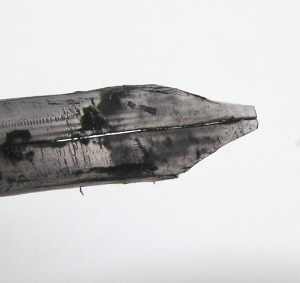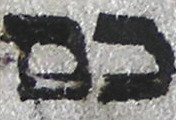
What causes this?
Well, think about a nib. In the normal way of things, the semiquills line up neatly, the ink channel is exactly the right width, the ink flow is smooth, and so the line produced is nice and even.

When the nib presses onto the page, it lays down the ink. Obviously, the ink channel itself is not doing any laying down of ink, because it is a gap between the two halves of the nib. When the gap is small and the ink abundant, surface tension takes care of that for you, laying down the ink regardless.
Sometimes (insert physics and chemistry here) that means the middle bits of the letters aren't stuck down as firmly as the edge bits, so several decades later, the middle bit is the first to flake off:

That won't happen until after you're dead, though (we plan long-term in this business...). Our present concern is what happens while the ink is still wet.
As we were saying, the ink channel itself is a gap, and when the gap is large enough and the inkflow light enough, writing doesn't happen in the gap. In non-Torah calligraphy, you can have fun with this; you can deliberately cut a notch in your nib, or you can buy scroll nibs for your fountain pen. It's rather a nice effect, really:

More soon...




No comments:
Post a Comment